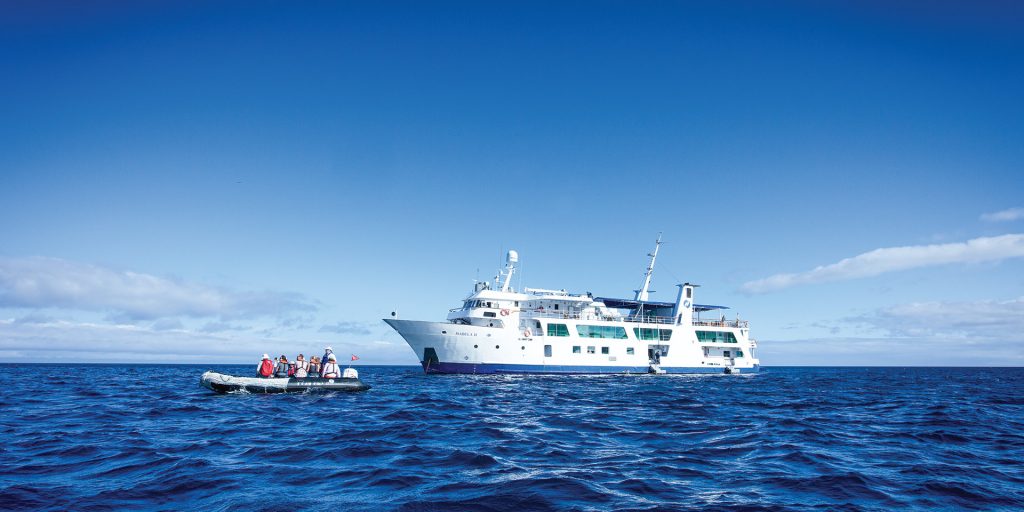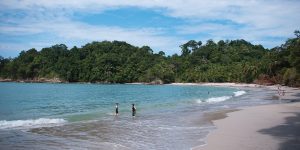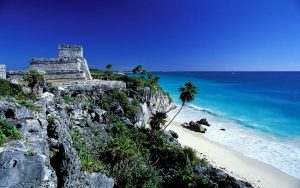Day 1 Santa Cruz Isl./Galapagos Islands
Very early this morning you will be transferred to the airport for your flight to Galapagos.
There are two types of landings throughout your Galapagos tour:
Dry landing: guests step from the dinghy onto rocks or a dock.
Wet landing: as the dinghy edges onto a sandy beach, guests step into knee-deep water and wade ashore.
Please remember that the exact route and program may vary according to weather and ocean conditions and the wildlife we encounter.
Morning arrival to Baltra Island by plane and immediate transfer to the dock to board your cruise. Welcome introductory briefing and lunch.
PM: Dragon Hill (Santa Cruz)- The visitor site at Dragon Hill has been open for visits on 1993. This site is located in northwestern Santa Cruz Island and consists of a trail that leads to a hyper-saline lagoon behind the beach, frequented by flamingos, pintail ducks and other species of birds. This site has been repopulated with land iguanas from Seymour, Isabela and Santa Cruz islands. There is a short walk to the Hill, which offers a beautiful view of the bay.
Day 2 Santa Cruz Isl./Galapagos Islands
AM: Black Turtle Cove (Santa Cruz)- This little cove is located at the northern side of Santa Cruz Island. This red mangrove lagoon very calm and quiet which made an ideal place as nursery for many sharks and rays. Its crystal waters permit to observe large groups of white-tip reef, black-tipped reef and hammerheads sharks, schools of golden rays and spotted eagle rays. There are no landing sites, so the visit is done by panga or kayak. Sea turtles are frequently seen, and sometimes they are seen mating in the mangrove-lined waters. Pelicans and Herons are also seen in this area.
PM: Chinese hat -This is a small islet (1 sq km) located just off the southeastern tip of Santiago Island. It is a recent volcanic cone, shaped like a Chinese hat when seen from the north side. On the west it can be seen lava formations, formed under the sea and raised upward, this is why coral heads are found on the lava. This is an excellent visit for interpretation of geological features such as lava tubes and lava flows. The landscape is covered by sea lions colonies, marine iguanas and Galapagos penguins.
Day 3 Genovesa Isl./Galapagos Islands
AM: Darwin Bay (Genovesa Island)- This bay has origin when the crater of this island collapsed below sea level. The wet landing is on a beautiful white coral sandy beach. This is a favourite island for birdwatchers: red footed-booby, masked boobies, wandering tattlers, lava gulls, whimbrels Yellow-crowned, black-crowned and lava herons, with and yellow warblers can be seen in the area. Continuing on the trail, visitors climb gradually to the edge of the cliff seeing Red-Foots nesting in the Mangrove trees below. Bird watching includes sightings of Sharp-Beaked Finches, Large Cactus and Ground Finches, Galapagos Doves and Swallow-Tailed Gulls. Reaching the end, the trail at the cliff’s edge offers an incredible view of the island and the many birds living there.
PM: El Barranco (Genovesa Island)- El Barranco is located in the southern part of Darwin Bay, and it is also known as Prince Philip’s Steps, passengers will climb to a plateau that is part of the stretch of land that surrounds Darwin Bay on its eastern side. There is a big population of Masked boobies and Red-Footed boobies in the tree; Storm petrels and Short-eared Owls have found in Genovesa lava flows the ideal place for nesting.
Day 4 Santiago Isl./Galapagos Islands
AM: Bartolomé Island- is situated across Sullivan Bay. It has an altitude of 114 meters, from where we can observe one of the most beautiful sceneries of the Galapagos Islands such as Volcanic cones, lunar-like craters, lava fields, and the famous Toba formed pinnacle eroded by the sea. There is very little vegetation on this island. It has two breathtaking beaches where marine turtles exist and at the base of the pinnacle, as well as a very small colony of Galapagos penguins.
PM: The Sullivan Bay (Santiago Island)- It is the fourth largest island in the archipelago (following Isabela, Fernandina and Santa Cruz). Along with some of the large western volcanoes of Isabela and Fernandina, Santiago is also volcanically active, with many young flows and cones to be seen, particularly along the south, west, and east coasts. These may even be seen from the summit of Darwin Volcano and space. Some historical eruptions have been reported over the last two centuries. Santiago consists of two coalesced volcanoes: a typical shield volcano on the northwest end and a low, linear fissure volcano on the southeast end.
Day 5 Galapagos Islands
AM: Highlands (Santa Cruz)- The trail to the highlands leaves from Bellavista and passes through the agricultural zone, near the National Park boundary, the Miconia Zone, and then goes to the Fern and Sedge zone. With clear weather (unpredictable), this area affords beautiful scenes of rolling hills and extinct volcanic cones covered with grass and lush greenery all year round. Then, transfer back to Baltra for your return flight to mainland.





















































